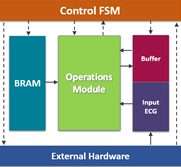A Computational Architecture for Inference of a Quantized-CNN for Detecting Atrial Fibrillation
Main Article Content
Keywords
Atrial fibrillation, Automatic detection, FPGA implementation, Quantized Convolutional Neural Network
Abstract
Atrial Fibrillation is a common cardiac arrhythmia, which is characterized by an abnormal heartbeat rhythm that can be life-threatening. Recently, researchers have proposed several Convolutional Neural Networks (CNNs) to detect Atrial Fibrillation. CNNs have high requirements on computing and memory resources, which usually demand the use of High Performance Computing (eg, GPUs). This high energy demand is a challenge for portable devices. Therefore, efficient hardware implementations are required. We propose a computational architecture for the inference of a Quantized Convolutional Neural Network (Q-CNN) that allows the detection of the Atrial Fibrillation (AF). The architecture exploits data-level parallelism by incorporating SIMD-based vector units, which is optimized in terms of computation and storage and also optimized to perform both the convolutional and fully connected layers. The computational architecture was implemented and tested in a Xilinx Artix-7 FPGA. We present the experimental results regarding the quantization process in a different number of bits, hardware resources, and precision. The results show an accuracy of 94% accuracy for 22-bits. This work aims to be the basis for the future implementation of a portable, low-cost, and high-reliability device for the diagnosis of Atrial Fibrillation.
Downloads
References
[2] A. Y. Hannun, P. Rajpurkar, M. Haghpanahi, G. H. Tison, C. Bourn, M. P. Turakhia, and A. Y. Ng, “ Cardiologist-level arrhythmia detection and classification in ambulatory electrocardiograms using a deep neural network,” Nature Medicine, vol. 25, no. 1, pp. 65–69, 2019. http://dx.doi.org/10.1038/s41591-018-0268-3
[3] P. A. Warrick and M. Nabhan Homsi, “ Ensembling convolutional and long short-term memory networks for electrocardiogram arrhythmia detection,” Physiological Measurement, vol. 39, no. 11, 2018. http://dx.doi.org/10.1088/1361-6579/aad386
[4] Z. Xiong, M. P. Nash, E. Cheng, V. V. Fedorov, M. K. Stiles, and J. Zhao, “ ECG signal classification for the detection of cardiac arrhythmias using a convolutional recurrent neural network,” Physiological Measurement, vol. 39, no. 9, 2018. http://dx.doi.org/10.1088/1361-6579/aad9ed
[5] T. Mahmud, S. A. Fattah, and M. Saquib, “Deeparrnet: An efficient deep cnn architecture for automatic arrhythmia detection and classification from denoised ecg beats,” IEEE Access, vol. 8, pp. 104 788–104 800, 2020. http://dx.doi.org/10.1109/ACCESS.2020.2998788
[6] Song Han, “ Efficient methods and hardware for deep learning,” Ph.D. disser- tation, Stanford University, 2017.
[7] D. Gschwend, “Zynqnet: An fpga-accelerated embedded convolutional neural network,” 2020. https://arxiv.org/pdf/2005.06892.pdf
[8] Y. Ma, Y. Cao, S. Vrudhula, and J. S. Seo, “ Optimizing loop operation and dataflow in FPGA acceleration of deep convolutional neural networks,” FPGA 2017 - Proceedings of the 2017 ACM/SIGDA International Symposium on Field-Programmable Gate Arrays, pp. 45–54, 2017. https://doi.org/10.1145/3020078.3021736
[9] J. Yu, Y. Hu, X. Ning, J. Qiu, K. Guo, Y. Wang, and H. Yang, “ Instruction driven cross-layer CNN accelerator with winograd transformation on FPGA,” 2017 International Conference on Field-Programmable Technology, ICFPT 2017, vol. 2018-Janua, pp. 227–230, 2018. https://doi.org/10.1109/ FPT.2017.8280147
[10] S. Sağlam, F. Tat, and S. Bayar, “Fpga implementation of cnn algorithm for detecting malaria diseased blood cells,” in 2019 International Symposium on Advanced Electrical and Communication Technologies (ISAECT). IEEE, 2019, pp. 1–5. http://dx.doi.org/10.1109/ISAECT47714.2019.9069724
[11] S. Zhang, J. Cao, Q. Zhang, Q. Zhang, Y. Zhang, and Y. Wang, “An fpga-based reconfigurable cnn accelerator for yolo,” in 2020 IEEE 3rd International Conference on Electronics Technology (ICET). IEEE, 2020, pp. 74–78. http://dx.doi.org/10.1109/ICET49382.2020.9119500
[12] E. Wang, J. J. Davis, R. Zhao, H.-C. Ng, X. Niu, W. Luk, P. Y. Cheung, and G. A. Constantinides, “Deep neural network approximation for custom hardware: Where we’ve been, where we’re going,” ACM Computing Surveys (CSUR), vol. 52, no. 2, pp. 1–39, 2019. https://doi.org/10.1145/3309551
[13] S. Mittal, “A survey of fpga-based accelerators for convolutional neural networks,” Neural computing and applications, vol. 32, pp. 1109–1139, 2020. https://doi.org/10.1007/s00521-018-3761-1
[14] J. A. Castillo, Y. C. Granados, and C. A. Fajardo, “ Patient-Specific Detection of Atrial Fibrillation in Segments of ECG Signals using Deep Neural Networks,” Ciencia E Ingenieria Neogranadina, vol. 30, no. 1, 2020. https://doi.org/10.18359/rcin.4156
[15] W. Uribe, M. Duque, and E. Medina, “Electrocardiografía y arritmias, ”Clínica Medellín. Editorial PLA Export Bogotá DC, pp. 41–5, 2005.
[16] H. Li, X. Fan, L. Jiao, W. Cao, X. Zhou, and L. Wang, “ A high performance FPGA-based accelerator for large-scale convolutional neural networks. ”EPFL, Aug 2016, pp. 1–9. https://doi.org/10.1109/FPL.2016.7577308
[17] A. Tisan, S. Oniga, D. MIC, and A. Buchman, “ Digital Implementation of The Sigmoid Function for FPGA Circuits,” Acta Technica Napocensis, vol. 50, no. 2, pp. 15–20, 2009.
[18] A. Goldberger, “ MIT-BIH atrial fibrillation database,” 2000. https://physionet.org/content/afdb/1.0.0/
[19] B. Jacob, S. Kligys, B. Chen, M. Zhu, M. Tang, A. Howard, H. Adam, and D. Kalenichenko, “ Quantization and Training of Neural Networks for Efficient Integer-Arithmetic-Only Inference,” Proceedings of the IEEE Computer Society Conference on Computer Vision and Pattern Recognition, pp. 2704–2713, 2018. https://doi.org/10.1109/CVPR.2018.00286
[20] Y. Dong, R. Ni, J. Li, Y. Chen, H. Su, and J. Zhu, “ Stochastic Quantization for Learning Accurate Low-Bit Deep Neural Networks,” International Journal of Computer Vision, vol. 127, no. 11, pp. 1629–1642, 2019. https://doi.org/10.1007/s11263-019-01168-2
M. Nagel, R. Amjad, M. Baalen, C. Louizos, and T. Blankevoort, “ Up or Down ? Adaptive Rounding for Post-Training Quantization,” 2020. https://arxiv.org/pdf/2004.10568.pdf

